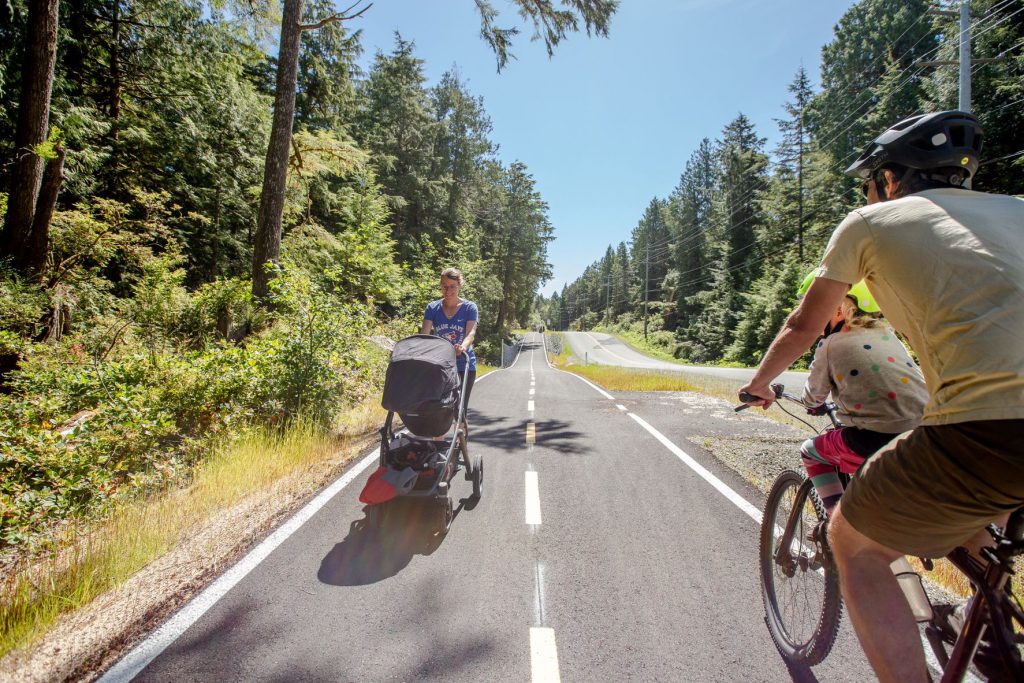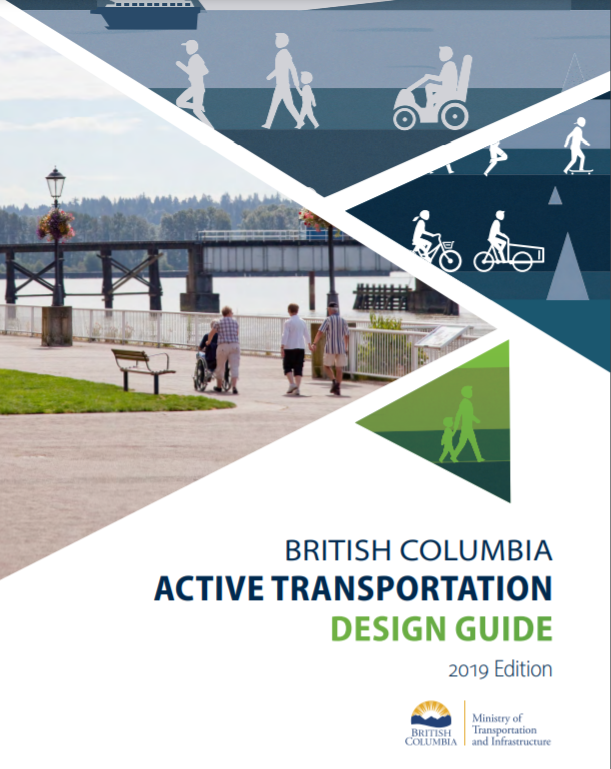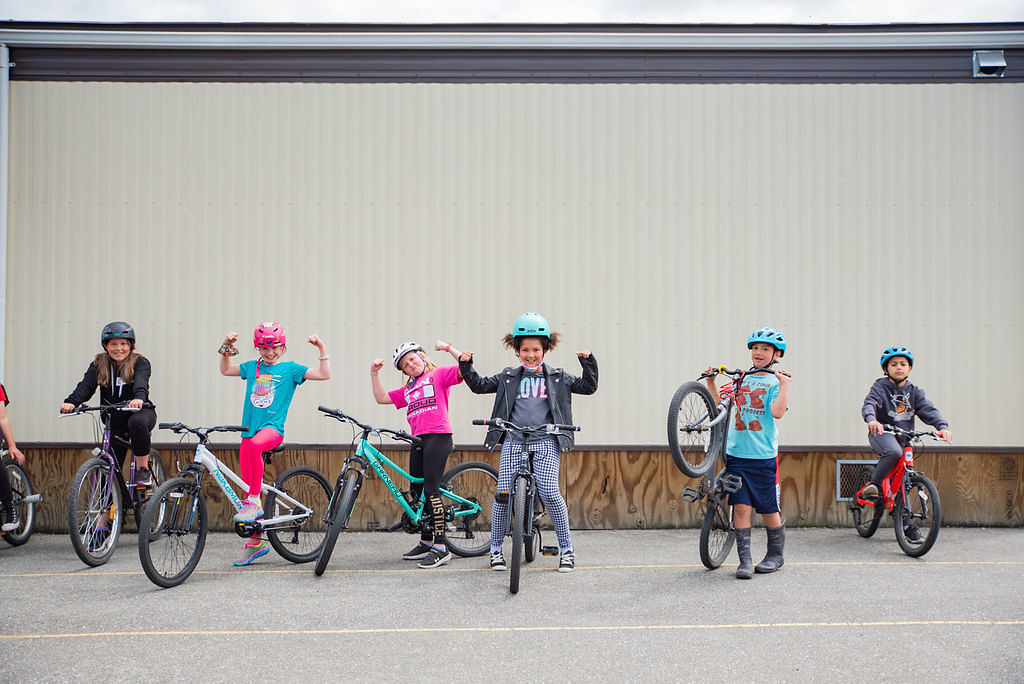
People are more excited than ever about active transportation. And for good reason; it’s an efficient, affordable, safe, climate-friendly way to get around. It’s pretty good for you, too!
Active transportation refers to various modes of self-propelled movement – from walking to wheelchair rolling, to skateboarding, scootering, and cycling – to get people to local destinations. Many people combine these modes with public transit to increase their range of travel, relying less on personal motor vehicles.
This shift towards active transportation is something we at the ministry are taking seriously. In fact, as part of BC’s active transportation strategy, Move. Commute. Connect, we’re aiming to double the percentage of trips taken by active transportation by 2030.
So, what are we doing to reach this goal? Let’s review some of the ways.
Types of Funding
There are many different ways we contribute funding for active transportation in BC.
As mentioned above, we incorporate active transportation facilities into new capital projects. We also contribute various grants.
The Active Transportation Infrastructure Grant Program offers two options for Indigenous governments and local governments, including municipalities, regional districts and Islands Trust.
- The Active Transportation Network Planning Grant helps communities develop active transportation network plans to support active transportation for all ages and abilities.
Thank you @TranBC for the $50,000 Active Transportation Network Planning grant! We look forward to planning how we can make active transportation more inviting for Sidney’s community members and visitors. pic.twitter.com/lZhC8q5hx1
— Town of Sidney (@townofsidneybc) September 23, 2021
2. The Active Transportation Infrastructure Grant goes toward the development of active transportation infrastructure for all ages and abilities, funding things such as:
-
- Multi-use protected travel lanes
- Pedestrian and cycling safety improvements
- End-of-trip facilities and other amenities
- Lighting and way-finding
For example, the Tofino Multi-Use-Path (MUP) Project (pictured at the top of this blog) developed a 2.8-kilometre separated two-way cycling path routed alongside the east side of Pacific Rim Highway from the Tofino Information Centre to the northern boundary of the Pacific Rim National Park (PRNP) to connect with the ʔapsčiik t̓ašii Trail.
Take a look at the list of 74 grant recipients for 2022/23 from across BC, who are moving their communities toward active transporation.
E-Bike Rebates
We know the distance to work, school and other activities can be a major factor in whether or not people choose active transportation. E-bikes are increasing in popularity because they provide greater speed, convenience and accessibility than non-assisted pedal bicycles.
Rebates on the purchase of an approved e-bike are available to BC residents older than 19 and will be based on a person’s income. Rebates will range from $350 to a maximum of $1,400. Unlike previous programs, there is no need to scrap a car to access the rebate.
This supports the Province’s CleanBC goals by encouraging shifts toward active transportation and public transit. E-bikes greatly reduce greenhouse gas emissions and offer a convenient alternative to replacing motor vehicle trips.
Active Transportation Design Guide
In 2019, we released the BC Active Transportation Design Guide to help all levels of government use best practices when designing and building active transportation infrastructure; take, for example, installing a separated, protected bike lane rather than marking a lane with a painted line, if possible.
The design guide helps transform how we get around in a way that reduces pollution and leads to better health for people, while making our communities cleaner and more liveable.
So far, the design guide has received regional, national and international awards.
- Regional: Greater Vancouver section of the Canadian Institute of Transportation Engineers for the Bill Curtis Award
- National: 2021 Award for Governmental Leadership in Sustainable Infrastructure from the Canadian Society for Civil Engineering
- International: Canadian Institute of Transportation Engineers Pedestrian and Bicycle Standing Committee John LaPlante Award in recognition that the guide applies innovative solutions and techniques related to pedestrian and bicycle activities

So, how is it applied?
The design guide is intended to be applied during the construction of new facilities and, when feasible, the rehabilitation of existing facilities.
For example, the guide is being used as part of the Fraser Valley Highway 1 Corridor Improvement Program to enhance pedestrian and cycling features as part of the Highway 1 – 216 St to 264 St widening and 264th to Whatcom improvement projects.
What the guide is not intended be is as an assessment tool to measure existing facilities or to trigger rehabilitation projects. For example, when we resurfaced Highway 19A this past summer, we were questioned about the width of the shoulders, which remained unchanged after repaving. Thing is, the project scope was to enhance safety by resurfacing the existing roadway and paved shoulders.
Widening shoulders for active transportation demands a much larger scope – it’s more costly, time consuming and may require multi-year planning for utility relocation, property acquisition, drainage changes, and so on. So, unfortunately, we can’t always pursue this route as part of regular highway rehabilitation requirements.
While capital projects (new construction) will factor in active transportation design guidelines, resurfacing projects are permitted to replace the existing conditions from when the roadway was originally constructed.
Policy and Legislation: Getting with the times
From e-scooters to e-skateboards, new technologies have ushered in more active transportation options over the years. Problem is, these devices aren’t technically allowed on public roads and sidewalks yet. It’s our job to bring the Motor Vehicle Act up to speed by working with communities to test ways to introduce them safely.
The electric kick scooter (i.e. e-scooter) pilot project is designed to do just that. Currently, the communities of Kelowna, Nanaimo, West Vancouver, North Vancouver (district and city), Vancouver, Richmond and Vernon are participating in a three-year pilot allowing the use of e-scooters in an effort to help us update our plans and regulations.
Active Transportation Education/Encouragement Programs
And just as this blog is meant to inform you about active transportation opportunities and encourage you to give it a try, we also work with community partners to support initiatives. For example, the EveryoneRides Grade 4 and 5, developed and delivered by HUB Cycling, teaches kids cycling skills and safety. Since the start of the program in 2019, more than 22,000 students have participated in a combination of online, in-class and on-bike learning. That’s a lot of up-and-coming avid cyclists! This skill development gives students the option to use the many new and upgraded cycling facilities that communities across the province have been building.

Community Safety Enhancement Program
Think of those little things that make active transportation better for communities – that’s what this program is all about. Examples of work completed to date under the program, which focuses on provincial roads, includes:
- Gabriola Island ferry entrance pedestrian safety improvements
- Flashing crosswalk to improve safety at Signal Hill Elementary School in Pemberton
- Shoulder construction Hariot Bay Road for pedestrians and cyclists on Quadra Island
Whoever you are, there are many active transportation options out there for you. Interested in learning more? Visit our active transportation website or visit the TranBC blog for related posts, including:
>> How to Keep Active Transportation Going in Winter
A month ago, I contacted Danny Morris, with MoTI regarding heavy debris and gravel covering a long section of the paved shoulder on Highway 6 westbound between Aberdeen Rd (Coldstream) and 15th Street (Vernon). The debris was thick enough that we could not ride a bicycle on that surface and necessitated riding in the traffic lane. Not a safe situation at all. This situation has persisted for more than a year.
Today we rode the same section again as the last part of a 32 km ride to Lavington. I was really happy to see that this safety hazard was rectified and want to send KUDOS out to Danny and the crew in Vernon/ North Okanagan for making this safe for cyclists.
Thank you Danny
Hi Susan,
Thank you so much for connecting with us here. We are glad to hear that the road is now safer for cyclists (and all road users). We will be sure to pass your kudos along to Danny and the team out there.
Safe travels!
Hello, the e-bike rebates link doesn’t work. Thank you!
Hi there – thanks for the flag. Here’s the link: https://bcebikerebates.ca/
Hi,
My question is about the Kettle Valley Rail Trail. After an atmospheric river hit the Pacific Northwest in November 2021, many parts of the KVR became unrideable due to extreme washouts and damage to the trail. As of today, many sections remain closed. Are there any plans to restore the trail or provide an alternative route? I hope there are because this is a great loss for the bike touring community and recreational riders who enjoyed the trail.
Great question, Sieva – we have sent it to our local area staff and will let you know what we hear back.
Hello again – our staff asks that you follow up with the RDOS (Regional District of the Okanagan-Similkameen) via their website or phoneline: https://www.rdos.bc.ca/helpful-links/contact-us/
To tranbceditor;
I was being sarcastic in my post from January 30, 2023 at 10:17 A.M.
I have no idea if and or when they’re going to do anything about the HWY 18’s shoulder.
I do intend to take a full set of photos and send it too them however.
This will at least make them aware of the problem from the last 14 years.
I shake my head at how little cyclists matter when it comes to keeping the shoulders of B.C.’s roads and highway’s in good order.
When I complain about it, the sweeper comes out to sweep the gravel ???
It would make economic sense to keep them in good order rather then spending millions on separate bike paths.
Speaking of good order, the shoulders on the Malahat are covered in so much debris and gravel that it’s un-ridable.
Hi again, Jeff. Thanks for clarifying. Our maintenance contractors are required to clear shoulders on a regular basis but, as you know – sand and debris do accumulate during the winter months more quickly due to weather.
The Malahat’s shoulder heading north on the down side very rarely gets done at all, years go by.
Thanks for sharing, Jeff. We encourage you to share anything that causes you concern directly with our maintenance contractor, as they are required to log all incoming concerns and this log is referenced by our staff when they conduct audits.
The maintenance contractor grated the should of HWY 18 from Lake Cowichan to Duncan.
This of course did nothing to improve the surface of it, in fact, it made it worse as the blade caught some of the crumbling pavement and broke it up even further.
How could they think that this is even helpful ?
Hello Jeff – thanks for connecting with us here. Have you shared this concern directly with the contractor?
Service Area 1 – South Island (Victoria)
EMCON Services Inc
Phone: 1-866-353-3136
Website: emconservices.ca
Twitter: @EmconSouthVI
Facebook: @emconservicesinc
I contacted Emcon by phone and I got this receptionist that recorded my concerns, she said that she will relay my message to Emcon when they are open.
It’s been many weeks; I’m being ignored.
That’s fairly typical too, I didn’t expect anything would happen.
What is the point of this web page if things continue to be ignored when there are real problems out there ?
If the shoulder had been in better shape and made wider, perhaps that head on collision that just recently happened could have been prevented as this would have provided a place for the driver to go to avoid the head on collision.
The shoulder is bad enough that a driver can’t pull into at highway speeds _ there’s no time to slow down to enter the shoulder.
Hi there, Jeff – thanks for this further information. We shared it with our area staff and they are going to head out and take a look.
Hi there,
Can the government legislate 30 km/h blanket speed limit on residential neighbourhoods, without needing to put signages up on every block? I think it is up to each city (ie: City of Vancouver) to decide on how to designate 30 km/h blanket speed limit?
Hi Ivan – thanks for your question. Unfortunately, no – the Province cannot as we (MOTI) only have jurisdiction over the provincial highway system and those areas fall outside that. We suggest you connect with your local municipality for more information. Hope this is helpful. Safe travels.
Hi. I live on Gabriola Island. We have so many bicycles here and no shoulders to speak off. The current pavement and chip seal are completely failing apart making cycling very dangerous especially since the contractor has not done any shoulder work in a decade.Is there a solution coming for us?
Hi there Cheryl – thanks for your question. We’ve shared it forward with our staff in your area and will let you know what we hear back.
Hello again Cheryl,
Here’s what we heard back. Unfortunately, funding for rehabilitation work is very limited. These funds are determined in late spring/early summer and will then be assigned to roads deemed to be of the greatest need. We can confirm that North Road and South Road are on the list to be reviewed for rehabilitation work, but will be prioritized against all other roads on central Vancouver Island for the limited funds.
Road maintenance issues (pot holes, shoulder drops, etc.) can be directly reported to Mainroad by calling their 1-877-215-6006 number. This generates a work order ticket that they must address.
We hope this information is helpful. Thanks again for reaching out to us. Safe travels.
There are countless roads all over Vancouver Island that are poorly maintained for cyclists and motorists alike.
Some, like where I live are so bad, I have to ride in the car lane, it’s not a pleasant place to be.
What is surprising is that there doesn’t seem to be any accidents because of this !
I’ve destroyed a number of expensive tires from crumbling pavement, and the areas where this has happened remain as they were, even after they know where they are.
No one seems to really care _ lots of excuses, it will take a death before the government wakes up.
Hi there, Jeff. If you have a concern about sweeping shoulder areas or the condition of shoulder areas – we ask that you share your concerns directly with our maintenance contractor responsible for the area. Here’s a link to their contact info:https://www2.gov.bc.ca/gov/content/transportation/transportation-infrastructure/contracting-to-transportation/highway-bridge-maintenance/highway-maintenance/contacts#SA01
I called the 1-866 number at EMCON and reported the state of the shoulder on HWY 18 from Lake Cowichan to Duncan
I’m sure it will be milled up and paved in a few months as time permits.
I believe that EMCON still needs the ministries permission to restore the shoulder, I think I’m just getting the run-around here.
Hi Jeff – thanks for this update. Your direct feedback does help. Our contractors work closely with our area staff to identify areas in need of improvement for future project planning.
The shoulder on the HWY 18 from Lake Cowichan to Duncan in B.C. has deteriorated to the point where the failed chip coat is gone and has exposed the gravel. It has become un-ridable for a proper road bike with narrow tires.
Cyclists are forced out into the car lane where we are continually abused by drivers.
I know how you people think, you won’t do anything until it’s starts costing the Province money in insurance claims and deaths.
Prove me wrong, mill up the shoulder and lay down some descent pavement.
Hi Jeff,
Thanks for your message. The ministry will review the condition of the seal coat shoulders to determine the scope and size of the project and will then determine the next steps. We may need to make any such repairs a part of a larger project. If necessary we will prioritize the project as part of our rehabilitation project list.
I guess the Ministry hasn’t reviewed anything yet, they did some paving on the Herd Road section and that’s it.
The shoulder continues to deteriorate, even more so where the logging trucks drive into the shoulder and cut the corners.
Kevin Falcon decided that it was a good idea to chip coat the shoulder and it just made things worse, that was more than 10 years ago now.
They grade it, but road bikes can’t be ridden on gravel, sometimes the even sweep the dirt _ what a waste of time, it needs new pavement !
The old Lake Cowichan HWY, is worse still, there is no shoulder to ride on, large sections of the pavement is gone and forces a cyclist out into the middle of the lane.
A small section of it was paved from the Tansor Road entrance to about 4 km in, and that’s where it stops.
Dear Madam/Sir
My apology when I am writing to you again. I am not sure if you got my first mail.
My daughter who is a registered nurse (single mom) will be working the night shift or being “On Call ” over the holidays and asked us to ” Baby Sit ”
We live in Lillooet and Highway 99 is open only for essential travel.
Would we be allowed to drive to Pemberton?
Thank you for your time
Good morning sir,
Based on yesterday’s press conference update – we expect that non essential travel will be allowed on BC Highways 3 and 99 early next week (Monday or Tuesday). We hope that this helps you plan your holiday travels. Take care.
nice post keep sharing with us
Thanks!